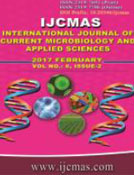


 National Academy of Agricultural Sciences (NAAS)
National Academy of Agricultural Sciences (NAAS)

|
PRINT ISSN : 2319-7692
Online ISSN : 2319-7706 Issues : 12 per year Publisher : Excellent Publishers Email : editorijcmas@gmail.com / submit@ijcmas.com Editor-in-chief: Dr.M.Prakash Index Copernicus ICV 2018: 95.39 NAAS RATING 2020: 5.38 |
Conservation agriculture (CA) has potential to changes soil physical, chemical and biological soil quality parameters compared to conventional tillage (CT) systems. The improved bio-physico-chemical soil quality in turn, affect the ecosystem services and sustainability of crop production system through counterbalancing the climate variability with the help of increasing sink for carbon sequestration within the soil. CA can also affect the functional diversity of soil microbes that essential for improved soil quality, crop production and many ecosystem services. In this context, we summarize the current status of know how CA and about the gaps in understanding, and highlight some research priorities for improving soil quality using CA practices. The review comprises of studies from diverse soil and ecologies of the world. There is clear evidence that CA improves soil physical quality by favouring soil aggregation, soil hydraulic conductivity, bulk density (BD) compared to CT. The combination of zero tillage (ZT) with crop residue retention increases chemical quality by improving the soil organic carbon (SOC) storage and macro and micro nutrient dynamics. Long term adoption of CA and residue management has a significant impact on soil fauna and flora communities under diversified crop rotations. The different soil microbes group responds differently to tillage disturbance and changed residue management strategies. However, in general tillage, through direct physical disruption as well as habitat destruction, strongly reduces macro-fauna including both litter transformers and ecosystem engineers. The above outlined evidence for the improved soil quality and production sustainability with well implemented CA systems is clear, although research remains inconclusive on some points. At the same time, the evidence for the degradation caused by tillage systems is convincing especially in tropical and sub-tropical conditions and for biological and physical soil quality. Therefore, even though we do not know how to manage functional CA systems under all conditions, the underlying principles of CA should provide the foundation upon which the development of new practices is based, rather than be considered a parallel option to mainstream research activities that focus on improving the current tillage-based production systems under diverse soil as well as ecological conditions.
 |
 |
 |
 |
 |